2005 RENAULT MEGANE wheel
[x] Cancel search: wheelPage 122 of 250
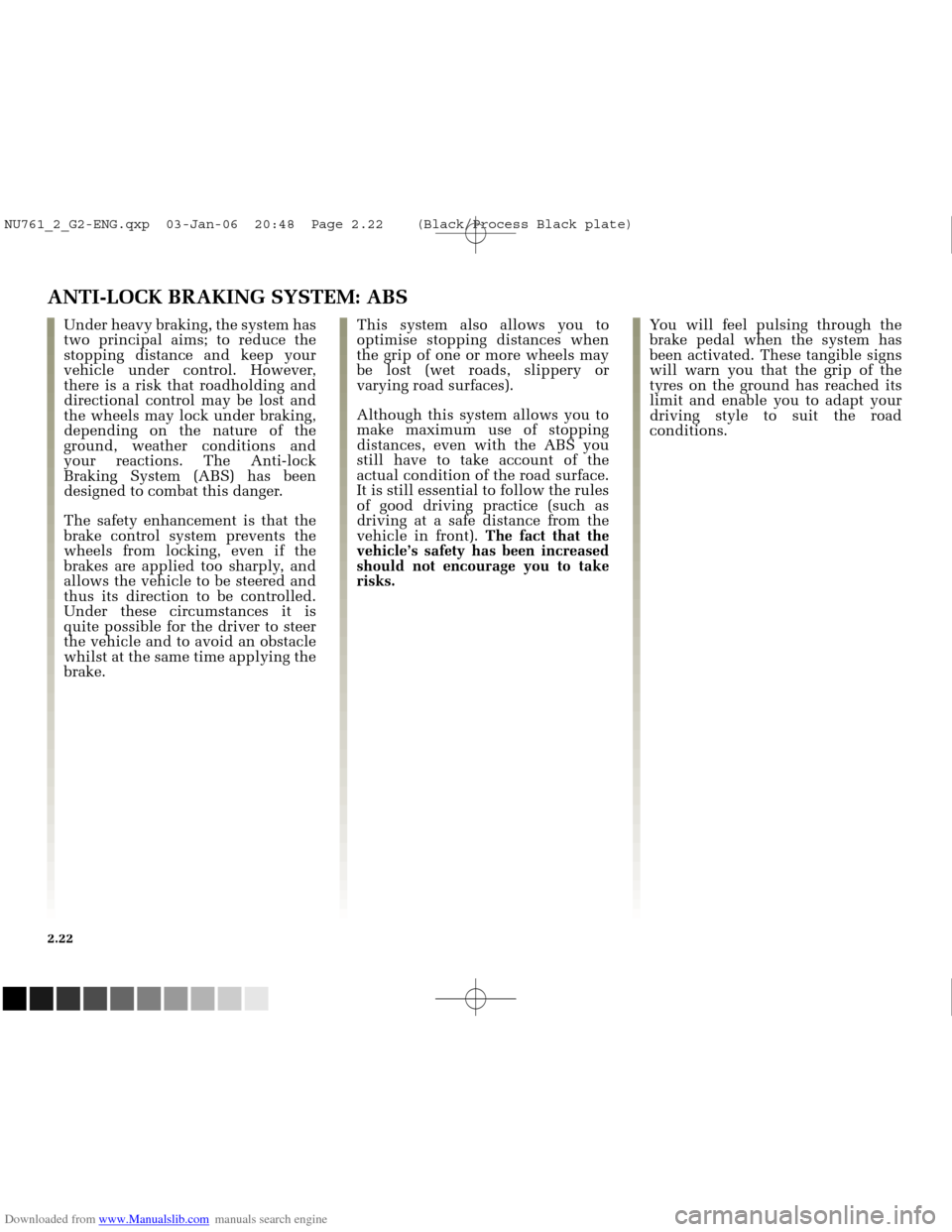
Downloaded from www.Manualslib.com manuals search engine
NU761_2_G2-FRA.qxd 4/11/05 10:48 Page 2.22
2.22
ANTI-LOCK BRAKING SYSTEM: ABS
You will feel pulsing through the
brake pedal when the system has
been activated. These tangible signs
will warn you that the grip of the
tyres on the ground has reached its
limit and enable you to adapt your
driving style to suit the road
conditions.
This system also allows you to
optimise stopping distances when
the grip of one or more wheels may
be lost (wet roads, slippery or
varying road surfaces).
Although this system allows you to
make maximum use of stopping
distances, even with the ABS you
still have to take account of the
actual condition of the road surface.
It is still essential to follow the rules
of good driving practice (such as
driving at a safe distance from the
vehicle in front).
The fact that the
vehicle’s safety has been increased
should not encourage you to take
risks.
Under heavy braking, the system has
two principal aims; to reduce the
stopping distance and keep your
vehicle under control. However,
there is a risk that roadholding and
directional control may be lost and
the wheels may lock under braking,
depending on the nature of the
ground, weather conditions and
your reactions. The Anti-lock
Braking System (ABS) has been
designed to combat this danger.
The safety enhancement is that the
brake control system prevents the
wheels from locking, even if the
brakes are applied too sharply, and
allows the vehicle to be steered and
thus its direction to be controlled.
Under these circumstances it is
quite possible for the driver to steer
the vehicle and to avoid an obstacle
whilst at the same time applying the
brake.
NU761_2_G2-ENG.qxp 03-Jan-06 20:48 Page 2.22 (Black/Process Black\
plate)
Page 136 of 250
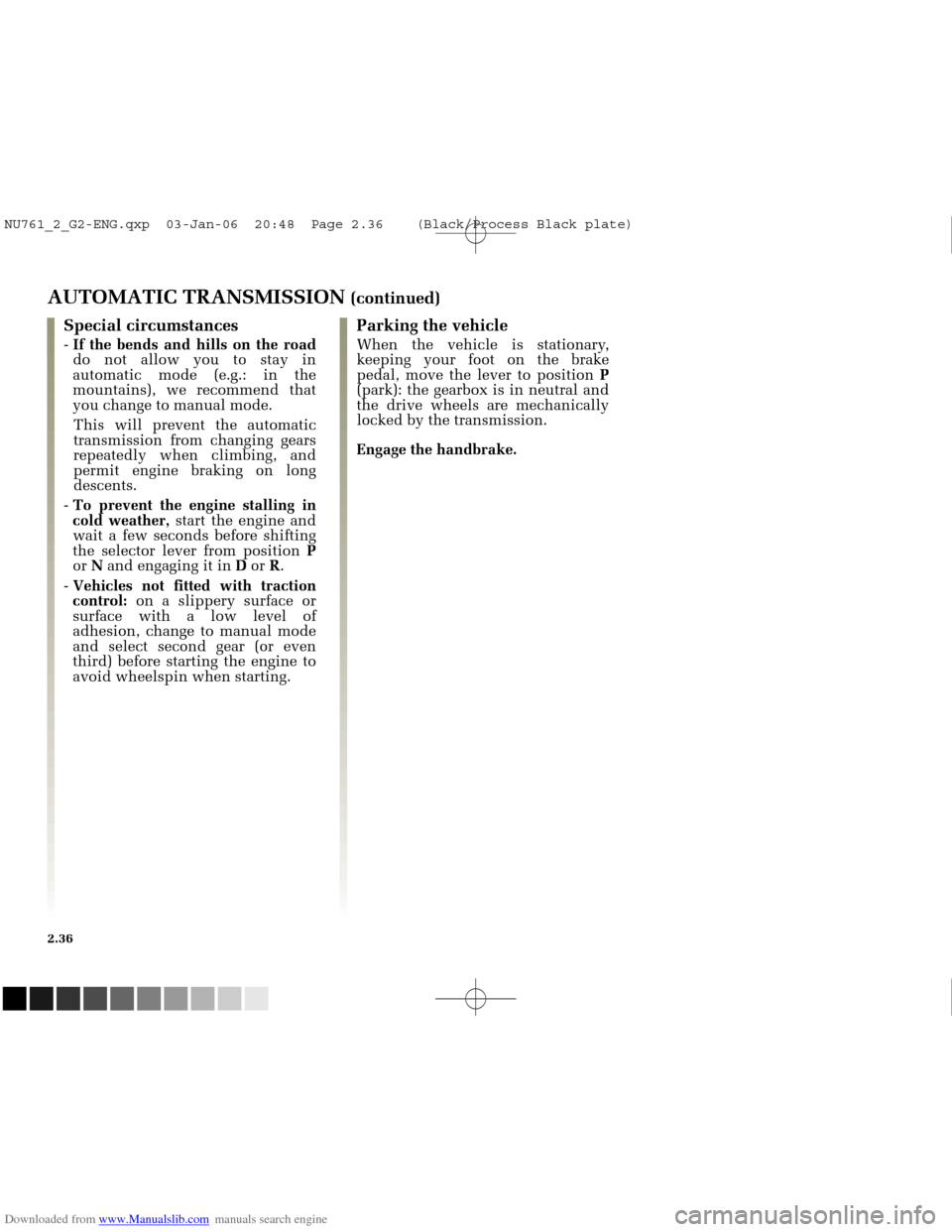
Downloaded from www.Manualslib.com manuals search engine
NU761_2_G2-FRA.qxd 4/11/05 10:48 Page 2.36
2.36
AUTOMATIC TRANSMISSION (continued)Parking the vehicle
When the vehicle is stationary,
keeping your foot on the brake
pedal, move the lever to position P
(park): the gearbox is in neutral and
the drive wheels are mechanically
locked by the transmission.
Engage the handbrake.
Special circumstances
- If the bends and hills on the road
do not allow you to stay in
automatic mode (e.g.: in the
mountains), we recommend that
you change to manual mode.
This will prevent the automatic
transmission from changing gears
repeatedly when climbing, and
permit engine braking on long
descents.
- To prevent the engine stalling in
cold weather, start the engine and
wait a few seconds before shifting
the selector lever from position P
or Nand engaging it in Dor R.
- Vehicles not fitted with traction
control: on a slippery surface or
surface with a low level of
adhesion, change to manual mode
and select second gear (or even
third) before starting the engine to
avoid wheelspin when starting.
NU761_2_G2-ENG.qxp 03-Jan-06 20:48 Page 2.36 (Black/Process Black\
plate)
Page 141 of 250
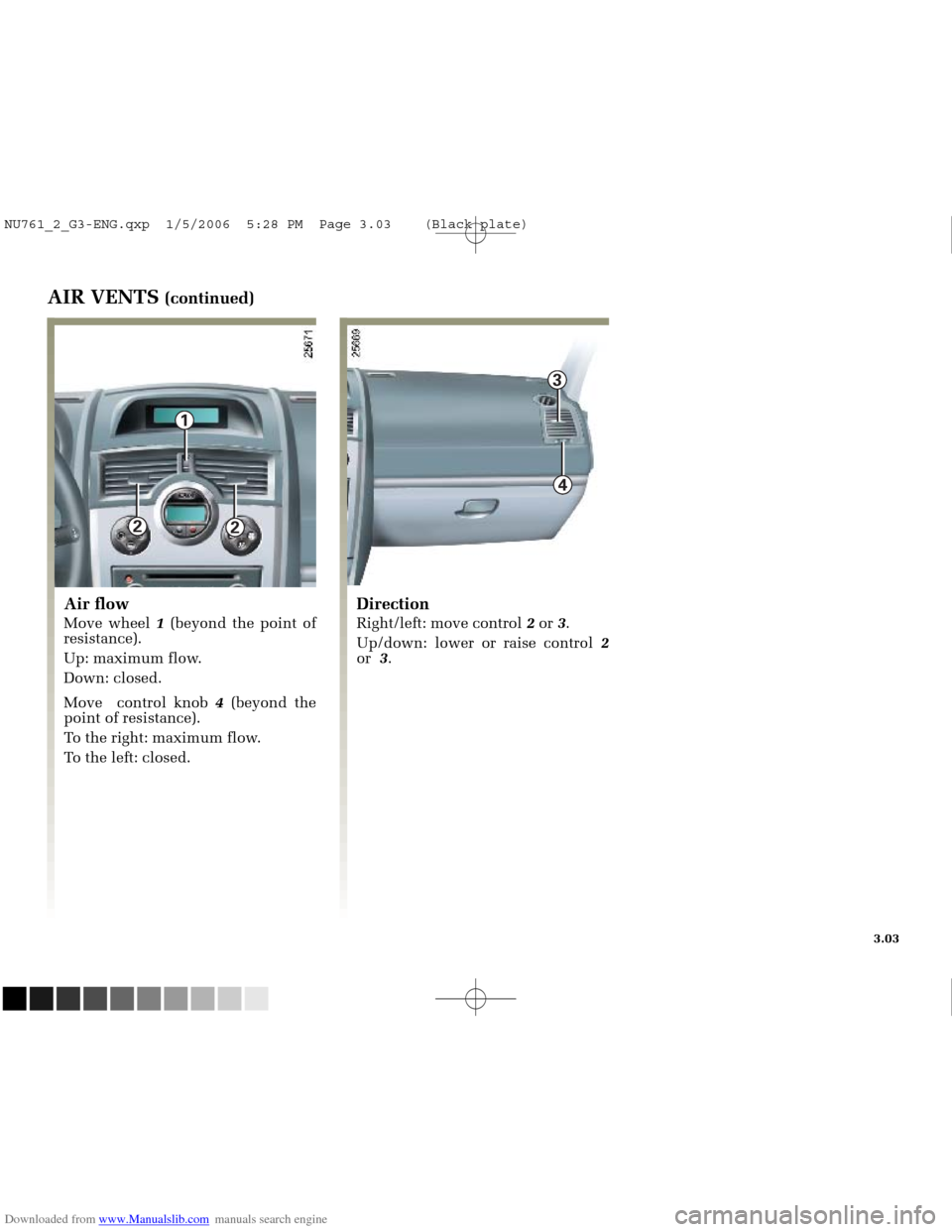
Downloaded from www.Manualslib.com manuals search engine
1
2
2
3
4
NU761_2_G3-FRA.qxd 4/11/05 10:50 Page 3.03
3.03
AIR VENTS (continued)
Air flow
Move wheel 1(beyond the point of
resistance).
Up: maximum flow.
Down: closed.
Move control knob 4(beyond the
point of resistance).
To the right: maximum flow.
To the left: closed.
Direction
Right/left: move control 2or 3.
Up/down: lower or raise control 2
or 3.
NU761_2_G3-ENG.qxp 1/5/2006 5:28 PM Page 3.03 (Black plate)
Page 171 of 250
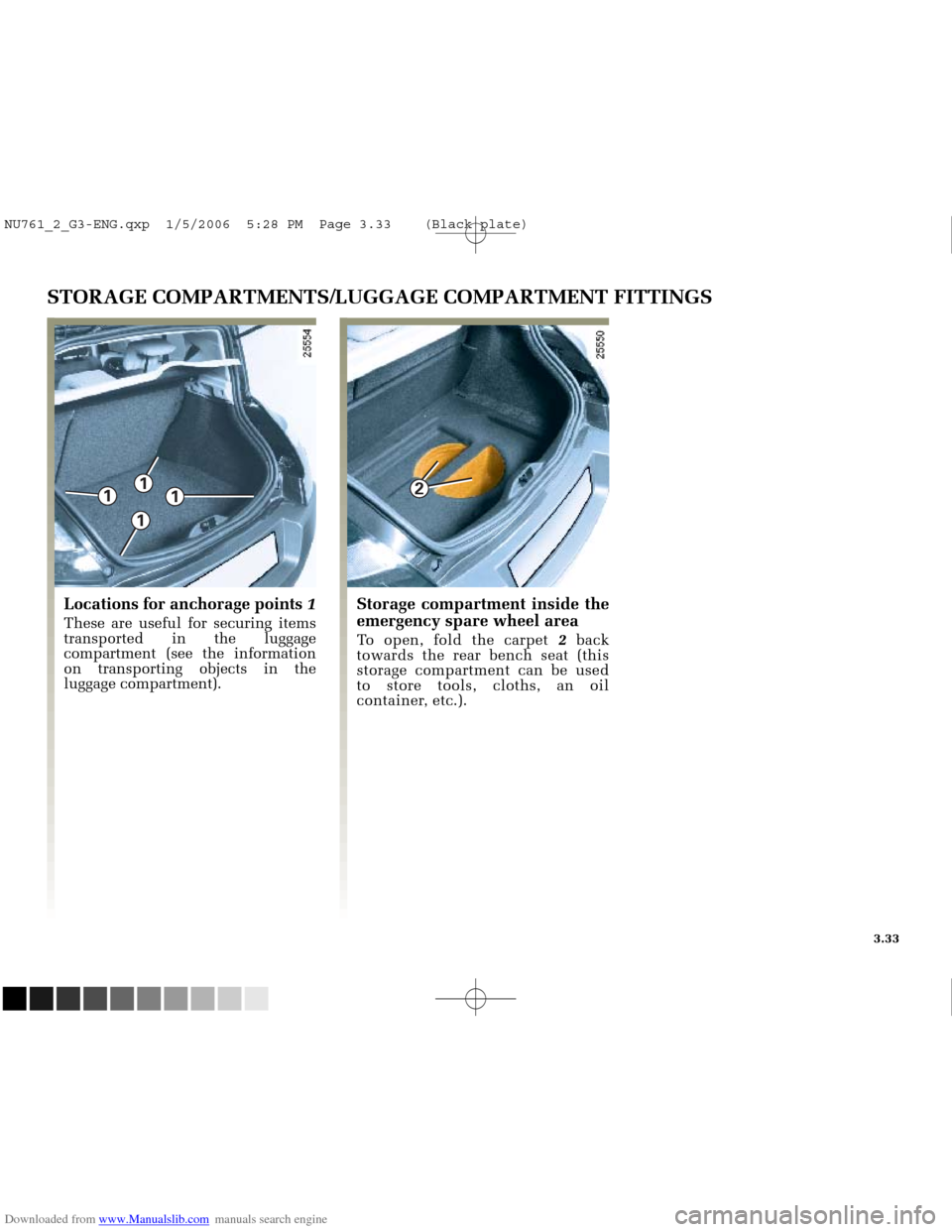
Downloaded from www.Manualslib.com manuals search engine
1
2
1
1
1
NU761_2_G3-FRA.qxd 4/11/05 10:52 Page 3.33
3.33
STORAGE COMPARTMENTS/LUGGAGE COMPARTMENT FITTINGS
Locations for anchorage points 1
These are useful for securing items
transported in the luggage
compartment (see the information
on transporting objects in the
luggage compartment).
Storage compartment inside the
emergency spare wheel area
To open, fold the carpet 2back
towards the rear bench seat (this
storage compartment can be used
to store tools, cloths, an oil
container, etc.).
NU761_2_G3-ENG.qxp 1/5/2006 5:28 PM Page 3.33 (Black plate)
Page 186 of 250
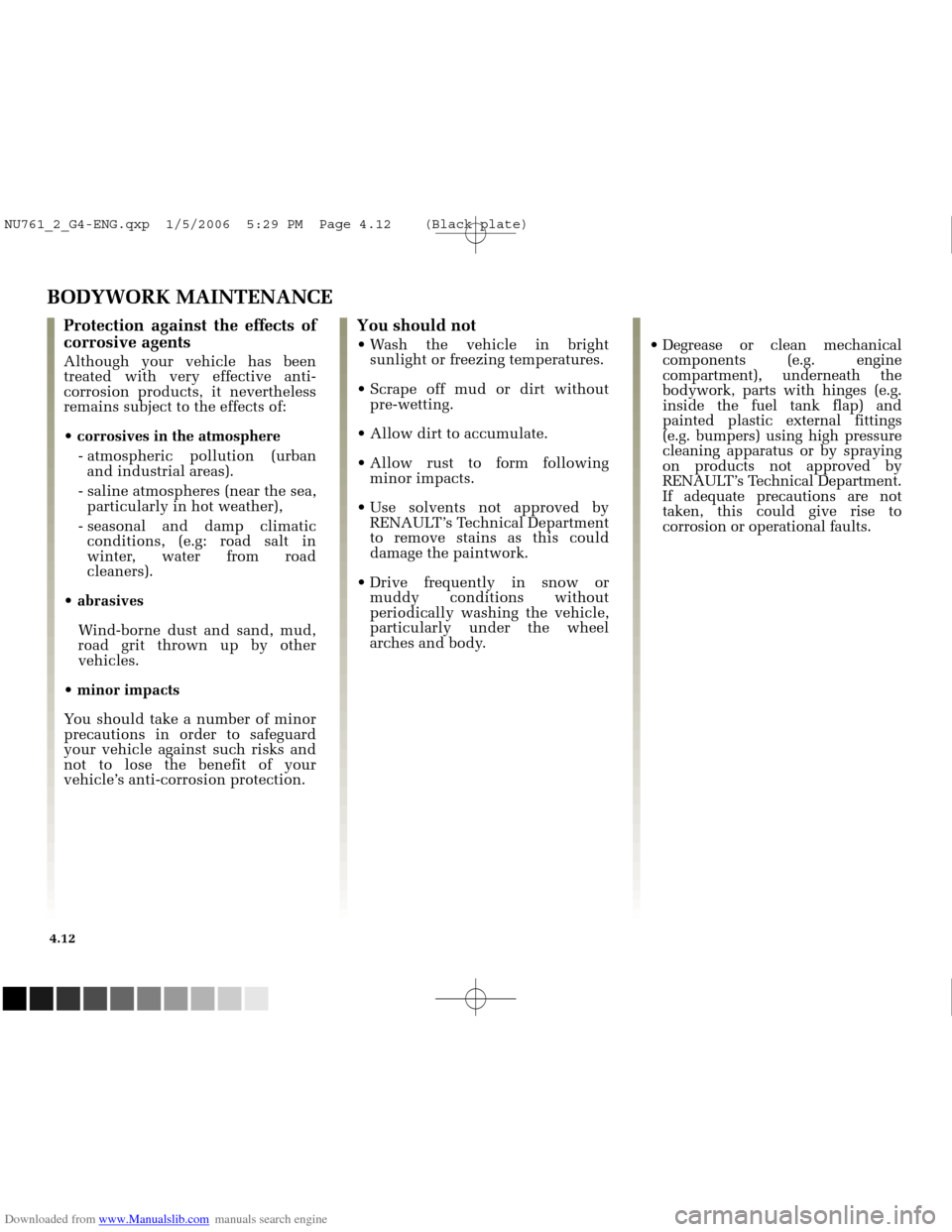
Downloaded from www.Manualslib.com manuals search engine
NU761_2_G4-FRA.qxd 14/11/05 10:11 Page 4.12
4.12
BODYWORK MAINTENANCE
Protection against the effects of
corrosive agents
Although your vehicle has been
treated with very effective anti-
corrosion products, it nevertheless
remains subject to the effects of:
• corrosives in the atmosphere- atmospheric pollution (urbanand industrial areas).
- saline atmospheres (near the sea, particularly in hot weather),
- seasonal and damp climatic conditions, (e.g: road salt in
winter, water from road
cleaners).
abrasives Wind-borne dust and sand, mud,
road grit thrown up by other
vehicles.
minor impacts
You should take a number of minor
precautions in order to safeguard
your vehicle against such risks and
not to lose the benefit of your
vehicle’s anti-corrosion protection.
You should not
Wash the vehicle in bright
sunlight or freezing temperatures.
Scrape off mud or dirt without
pre-wetting.
Allow dirt to accumulate.
Allow rust to form following
minor impacts.
Use solvents not approved by
RENAULT’s Technical Department
to remove stains as this could
damage the paintwork.
Drive frequently in snow or
muddy conditions without
periodically washing the vehicle,
particularly under the wheel
arches and body.
Degrease or clean mechanical
components (e.g. engine
compartment), underneath the
bodywork, parts with hinges (e.g.
inside the fuel tank flap) and
painted plastic external fittings
(e.g. bumpers) using high pressure
cleaning apparatus or by spraying
on products not approved by
RENAULT’s Technical Department.
If adequate precautions are not
taken, this could give rise to
corrosion or operational faults.
NU761_2_G4-ENG.qxp 1/5/2006 5:29 PM Page 4.12 (Black plate)
Page 187 of 250
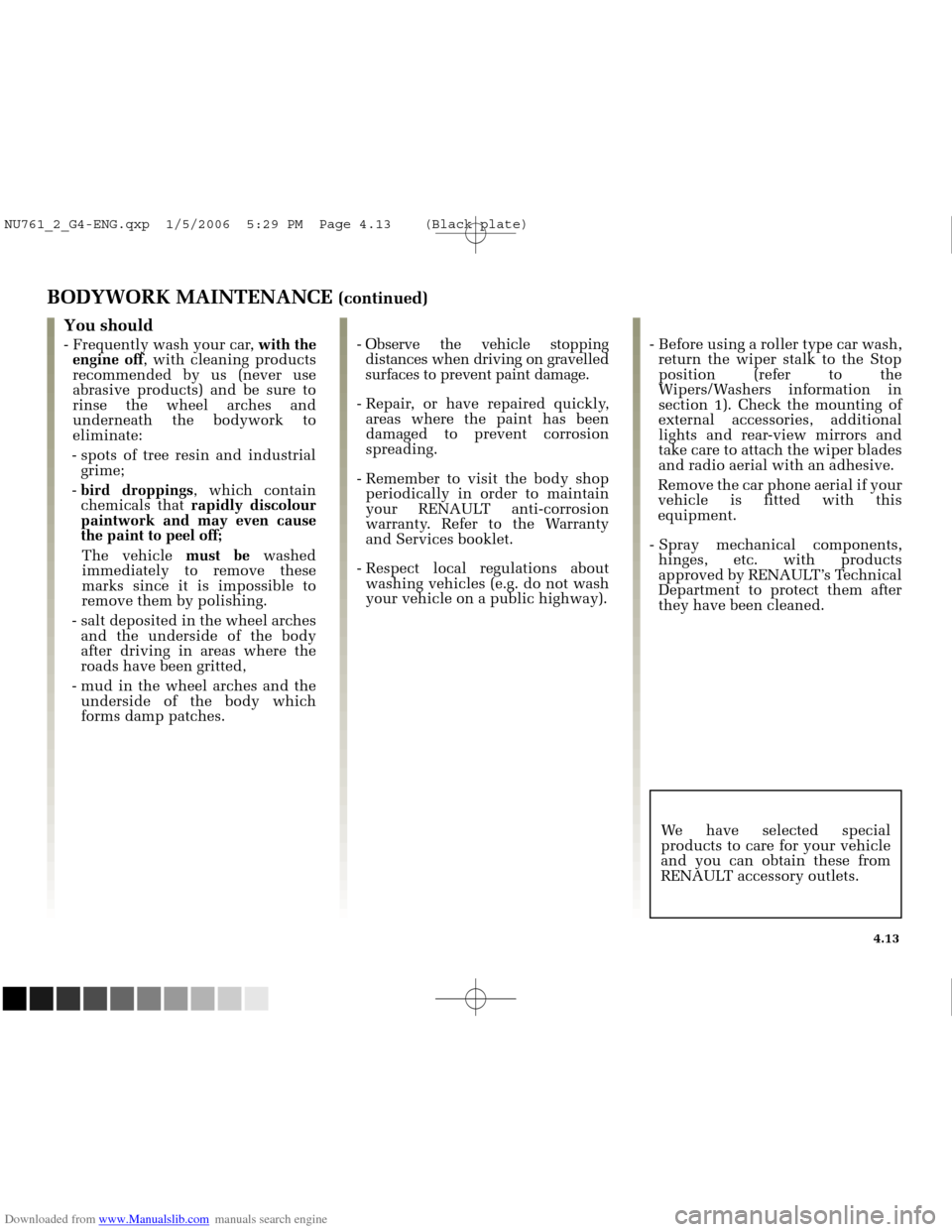
Downloaded from www.Manualslib.com manuals search engine
NU761_2_G4-FRA.qxd 14/11/05 10:11 Page 4.13
4.13
BODYWORK MAINTENANCE (continued)
You should
- Frequently wash your car, with the
engine off , with cleaning products
recommended by us (never use
abrasive products) and be sure to
rinse the wheel arches and
underneath the bodywork to
eliminate:
- spots of tree resin and industrial grime;
- bird droppings , which contain
chemicals that rapidly discolour
paintwork and may even cause
the paint to peel off;
The vehicle must bewashed
immediately to remove these
marks since it is impossible to
remove them by polishing.
- salt deposited in the wheel arches and the underside of the body
after driving in areas where the
roads have been gritted,
- mud in the wheel arches and the underside of the body which
forms damp patches. - Observe the vehicle stopping
distances when driving on gravelled
surfaces to prevent paint damage.
- Repair, or have repaired quickly, areas where the paint has been
damaged to prevent corrosion
spreading.
- Remember to visit the body shop periodically in order to maintain
your RENAULT anti-corrosion
warranty. Refer to the Warranty
and Services booklet.
- Respect local regulations about washing vehicles (e.g. do not wash
your vehicle on a public highway). - Before using a roller type car wash,
return the wiper stalk to the Stop
position (refer to the
Wipers/Washers information in
section 1). Check the mounting of
external accessories, additional
lights and rear-view mirrors and
take care to attach the wiper blades
and radio aerial with an adhesive.
Remove the car phone aerial if your
vehicle is fitted with this
equipment.
- Spray mechanical components, hinges, etc. with products
approved by RENAULT’s Technical
Department to protect them after
they have been cleaned.
We have selected special
products to care for your vehicle
and you can obtain these from
RENAULT accessory outlets.
NU761_2_G4-ENG.qxp 1/5/2006 5:29 PM Page 4.13 (Black plate)
Page 189 of 250
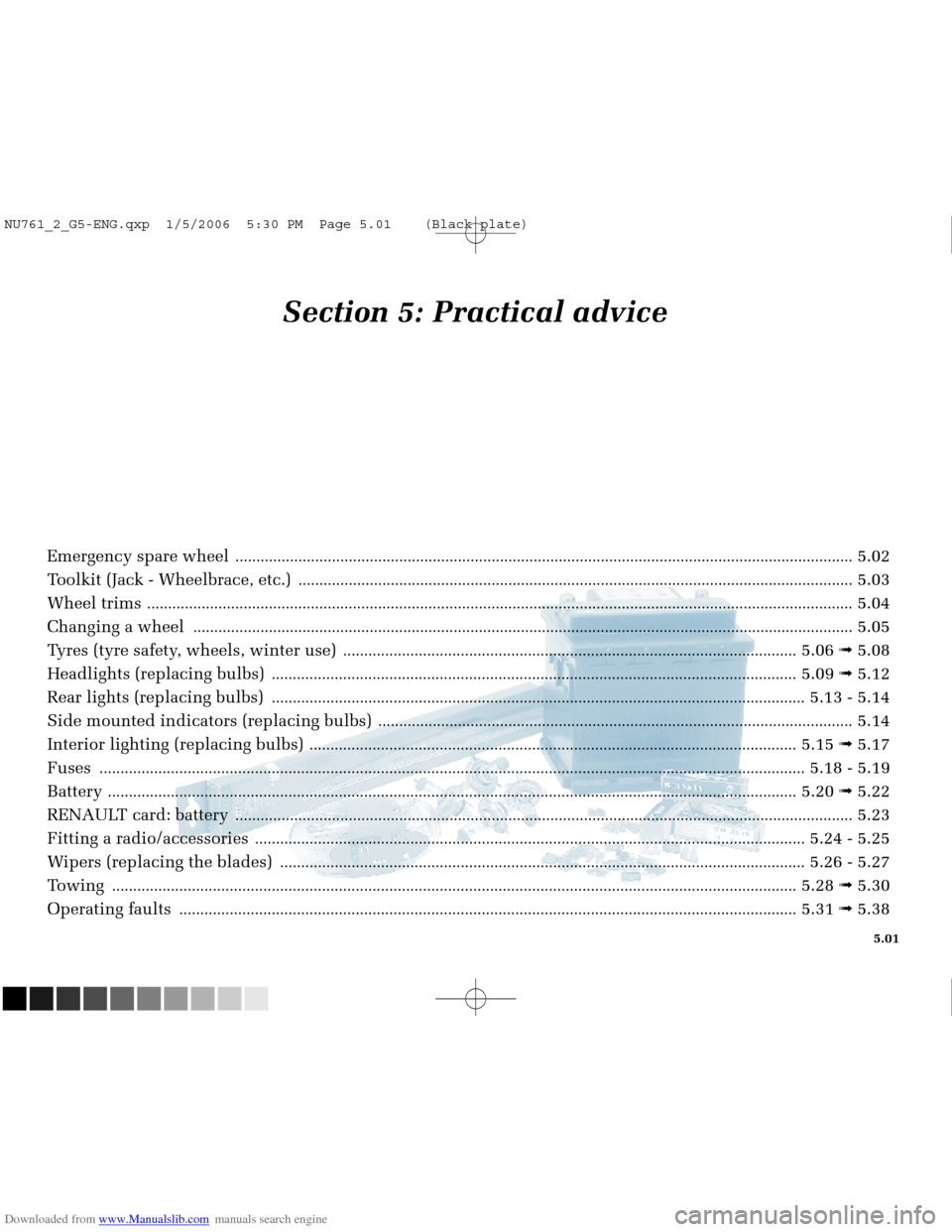
Downloaded from www.Manualslib.com manuals search engine
NU761_2_G5-FRA.qxd 4/11/05 11:09 Page 5.01
Section 5: Practical advice
Emergency spare wheel ........................................................................\
...........................................................................5.02
Toolkit (Jack - Wheelbrace, etc.)
........................................................................\
....................................................... .....5.03
Wheel trims
........................................................................\
....................................................... .........................................5.04
Changing a wheel
........................................................................\
....................................................... ..............................5.05
Tyres (tyre safety, wheels, winter use)
........................................................................\
....................................5.06 ➟5.08
Headlights (replacing bulbs)
........................................................................\
.....................................................5.09 ➟5.12
Rear lights (replacing bulbs)
........................................................................\
.......................................................5.13 - 5.14
Side mounted indicators (replacing bulbs)
........................................................................\
.........................................5.14
Interior lighting (replacing bulbs)
........................................................................\
............................................5.15 ➟5.17
Fuses
........................................................................\
....................................................... .........................................5.18 - 5.19
Battery
........................................................................\
....................................................... .....................................5.20 ➟5.22
RENAULT card: battery
........................................................................\
....................................................... ....................5.23
Fitting a radio/accessories
........................................................................\
....................................................... ....5.24 - 5.25
Wipers (replacing the blades)
........................................................................\
.....................................................5.26 - 5.27
Towing
........................................................................\
....................................................... ....................................5.28 ➟5.30
Operating faults
........................................................................\
....................................................... ....................5.31 ➟5.38
5.01
NU761_2_G5-ENG.qxp 1/5/2006 5:30 PM Page 5.01 (Black plate)
Page 190 of 250
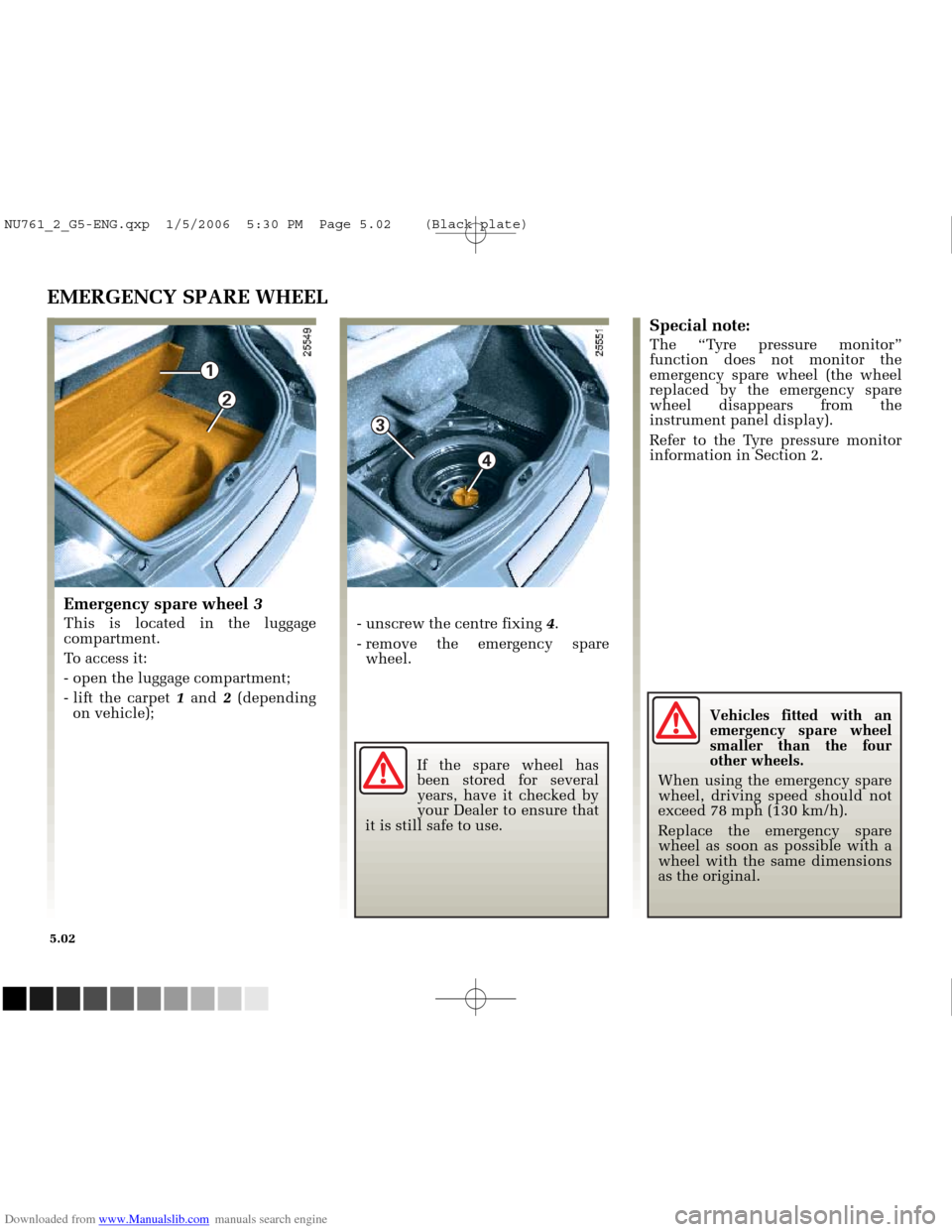
Downloaded from www.Manualslib.com manuals search engine
1
4
3
2
NU761_2_G5-FRA.qxd 4/11/05 11:09 Page 5.02
5.02
EMERGENCY SPARE WHEEL
Emergency spare wheel 3
This is located in the luggage
compartment.
To access it:
- open the luggage compartment;
- lift the carpet 1and 2(depending
on vehicle);
Special note:
The “Tyre pressure monitor”
function does not monitor the
emergency spare wheel (the wheel
replaced by the emergency spare
wheel disappears from the
instrument panel display).
Refer to the Tyre pressure monitor
information in Section 2.
- unscrew the centre fixing 4.
- remove the emergency spare wheel.
If the spare wheel has
been stored for several
years, have it checked by
your Dealer to ensure that
it is still safe to use. Vehicles fitted with an
emergency spare wheel
smaller than the four
other wheels.
When using the emergency spare
wheel, driving speed should not
exceed 78 mph (130 km/h).
Replace the emergency spare
wheel as soon as possible with a
wheel with the same dimensions
as the original.
NU761_2_G5-ENG.qxp 1/5/2006 5:30 PM Page 5.02 (Black plate)